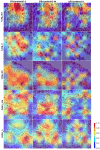An Explainable Classification Method Based on Complex Scaling in Histopathology Images for Lung and Colon Cancer
- PMID: 37174985
- PMCID: PMC10178684
- DOI: 10.3390/diagnostics13091594
An Explainable Classification Method Based on Complex Scaling in Histopathology Images for Lung and Colon Cancer
Abstract
Lung and colon cancers are among the leading causes of human mortality and morbidity. Early diagnostic work up of these diseases include radiography, ultrasound, magnetic resonance imaging, and computed tomography. Certain blood tumor markers for carcinoma lung and colon also aid in the diagnosis. Despite the lab and diagnostic imaging, histopathology remains the gold standard, which provides cell-level images of tissue under examination. To read these images, a histopathologist spends a large amount of time. Furthermore, using conventional diagnostic methods involve high-end equipment as well. This leads to limited number of patients getting final diagnosis and early treatment. In addition, there are chances of inter-observer errors. In recent years, deep learning has shown promising results in the medical field. This has helped in early diagnosis and treatment according to severity of disease. With the help of EffcientNetV2 models that have been cross-validated and tested fivefold, we propose an automated method for detecting lung (lung adenocarcinoma, lung benign, and lung squamous cell carcinoma) and colon (colon adenocarcinoma and colon benign) cancer subtypes from LC25000 histopathology images. A state-of-the-art deep learning architecture based on the principles of compound scaling and progressive learning, EffcientNetV2 large, medium, and small models. An accuracy of 99.97%, AUC of 99.99%, F1-score of 99.97%, balanced accuracy of 99.97%, and Matthew's correlation coefficient of 99.96% were obtained on the test set using the EffcientNetV2-L model for the 5-class classification of lung and colon cancers, outperforming the existing methods. Using gradCAM, we created visual saliency maps to precisely locate the vital regions in the histopathology images from the test set where the models put more attention during cancer subtype predictions. This visual saliency maps may potentially assist pathologists to design better treatment strategies. Therefore, it is possible to use the proposed pipeline in clinical settings for fully automated lung and colon cancer detection from histopathology images with explainability.
Keywords: EffcientNetV2; colon cancer; explainability; histopathology; lung cancer.
Conflict of interest statement
The authors declare no conflict of interest.
Figures




Similar articles
-
DeepHistoNet: A robust deep-learning model for the classification of hepatocellular, lung, and colon carcinoma.Microsc Res Tech. 2024 Feb;87(2):229-256. doi: 10.1002/jemt.24426. Epub 2023 Sep 26. Microsc Res Tech. 2024. PMID: 37750465
-
Colon and lung cancer classification from multi-modal images using resilient and efficient neural network architectures.Heliyon. 2024 May 3;10(9):e30625. doi: 10.1016/j.heliyon.2024.e30625. eCollection 2024 May 15. Heliyon. 2024. PMID: 38742084 Free PMC article.
-
Advancing cancer diagnosis and prognostication through deep learning mastery in breast, colon, and lung histopathology with ResoMergeNet.Comput Biol Med. 2025 Feb;185:109494. doi: 10.1016/j.compbiomed.2024.109494. Epub 2024 Dec 4. Comput Biol Med. 2025. PMID: 39637456
-
Deep Learning Methods for Lung Cancer Segmentation in Whole-Slide Histopathology Images-The ACDC@LungHP Challenge 2019.IEEE J Biomed Health Inform. 2021 Feb;25(2):429-440. doi: 10.1109/JBHI.2020.3039741. Epub 2021 Feb 5. IEEE J Biomed Health Inform. 2021. PMID: 33216724 Review.
-
Breast cancer cell nuclei classification in histopathology images using deep neural networks.Int J Comput Assist Radiol Surg. 2018 Feb;13(2):179-191. doi: 10.1007/s11548-017-1663-9. Epub 2017 Aug 31. Int J Comput Assist Radiol Surg. 2018. PMID: 28861708 Review.
Cited by
-
Predictive analytics of complex healthcare systems using deep learning based disease diagnosis model.Sci Rep. 2024 Nov 11;14(1):27497. doi: 10.1038/s41598-024-78015-z. Sci Rep. 2024. PMID: 39528485 Free PMC article.
-
An Efficient Combination of Convolutional Neural Network and LightGBM Algorithm for Lung Cancer Histopathology Classification.Diagnostics (Basel). 2023 Jul 25;13(15):2469. doi: 10.3390/diagnostics13152469. Diagnostics (Basel). 2023. PMID: 37568831 Free PMC article.
-
An enhanced fusion of transfer learning models with optimization based clinical diagnosis of lung and colon cancer using biomedical imaging.Sci Rep. 2025 Jul 7;15(1):24247. doi: 10.1038/s41598-025-10246-0. Sci Rep. 2025. PMID: 40624106 Free PMC article.
-
Advanced deep learning for multi-class colorectal cancer histopathology: integrating transfer learning and ensemble methods.Quant Imaging Med Surg. 2025 Mar 3;15(3):2329-2346. doi: 10.21037/qims-24-1641. Epub 2025 Feb 26. Quant Imaging Med Surg. 2025. PMID: 40160652 Free PMC article.
-
Weighing the benefits of lymphadenectomy in early-stage colorectal cancer.Ann Surg Treat Res. 2023 Nov;105(5):245-251. doi: 10.4174/astr.2023.105.5.245. Epub 2023 Oct 31. Ann Surg Treat Res. 2023. PMID: 38023437 Free PMC article. Review.
References
-
- Krizhevsky A., Sutskever I., Hinton G.E. ImageNet Classification with Deep Convolutional Neural Networks. Adv. Neural Inf. Process. Syst. 2012;25:84–90. doi: 10.1145/3065386. - DOI
-
- Simonyan K., Zisserman A. Very Deep Convolutional Networks for Large-Scale Image Recognition. arXiv. 20141409.1556
LinkOut - more resources
Full Text Sources
Miscellaneous

